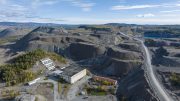As the energy revolution gathers momentum, so too intensifies the pressure from the investment community on miners to create net-zero emissions operations that produce sustainable upstream products feeding the new green economy, a panel heard during the Precious Metals Summit in Beaver Creek, Colo.
According to Jamie Keech, executive chairman of Vida Carbon Corp., a pool of about US$39 trillion of capital has been committed to de-investing from oil and gas.
“That money all has to go somewhere, and there’s tremendous pressure on capital allocators to put that money to more environmentally friendly uses,” he told the summit.
Keech said investors, limited partnerships and governments were exercising tremendous pressure on corporations, particularly in the mining space.
Even top investment funds such as Blackrock’s Larry Fink have said that if a company in their portfolios didn’t have a carbon reduction strategy in place by 2030, then the finance taps are getting turned off.
“These materials and metals we’re mining are critical for the transition to a renewable and a net-zero future. So, suppose you are a mining company involved with this transition and put a climate action strategy on top of that. In that case, you bet your bottom dollar that large capital allocators will look at you instead of companies without such policies,” said Keech.
Karora Resources (TSX: KKR) executive VP for corporate development Oliver Turner stressed that the rise of the carbon credit market all boils down to reducing the cost of capital.
“If you are raising money from debt, you will have a reduced cost of capital if you abide by these principles and all that ties into the ESG theme. And I think the most important part of this must be the carbon credits and how those contribute to achieving these goals and lowering the cost of capital,” he told the summit. “It’s lowering dilution and creating higher returns for shareholders.”
Star Royalties‘ (TSXV: STRR) CEO Alex Pernin said the market was developing exponentially. According to Pernin, the market is growing via two main drivers — those companies that seek to comply with regulations and those seeking to voluntarily comply to improve their investability status from an ESG perspective.
“On the compliance side, the market is at a several US$100 billion level right now,” he told the summit.
“What’s more exciting to talk about,” said Pernin, “is voluntary growth. Five years ago, in 2017, the voluntary [sector] was a $200 million market — very tiny. Two years ago, it doubled to about US$500 million and quadrupled to a US$2 billion market last year. So, in five years, this market has gone up 10 times, and then there’s an expectation the market could balloon to US$30 or US$50 billion by the end of this decade.”
According to the panel, fossil fuels multinational Royal Dutch Shell recently said it would require about 120 million carbon credit offsets a year to be carbon neutral. That’s about US$1.2 billion in investment from one company alone to offset its carbon emissions at today’s average carbon unit price.
“It’s unreal to have a single company expressing the need to buy half the carbon market in a given year,” said Pernin.
“Because of the level of demand for it, there’s a natural escalator, as you would expect, for carbon prices to come up. What’s interesting with the carbon world is that these technological solutions we’ve discussed require higher pricing based on the economic need. Not US$40 carbon but US$100 to US$150 pricing for it to be viable. And we need these products to be viable to meet the Paris Agreement targets,” said Pernin.
Advice for miners
The panel offered advice for mineral explorers and miners, saying compliance starts via physical emissions reduction at site by using new technologies such as electrified and autonomous equipment and renewable energy sources to power operations.
“There’s absolutely no doubt that it’s becoming economical to do that versus the combustion engine counterparts. You must offset what you cannot reduce in emissions to be carbon neutral, and ultimately, to be net zero,” said Keech.
Inventa Capital managing partner and co-founder Michael Konnert said the price escalation piece was important for miners starting the emissions reduction journey. “As the CFO of my company, I’m looking at the enormous future liability over the next 10, 15 to 20 years as prices per unit offset the increase,” he said.
In his view, there are two solutions. One is to work with a carbon offset company to purchase or secure long-term offtake credits. “So, I can lock in my price of carbon over time. As a CFO, I look like a genius, right? You’re hedging that future price risk,” said Konnert.
Pernin said it was very much still a matter of seeing how the industry evolves, but ostensibly, he already sees creative ways of administering carbon offsets in the future.
“It will be quite creative, as, for example, the precious metals division might be able to tack on carbon credit streams to the operators. So, imagine you are a million ounce producer, and you close a metals stream with us. We might, in future, be able to layer in some of these carbon credits so that not only is it an attractive source of capital for you, but you could also offset some of your production, which ideally acts to lower the cost of capital,” he added.





Be the first to comment on "Beaver Creek: Miners should hedge future carbon offset costs"